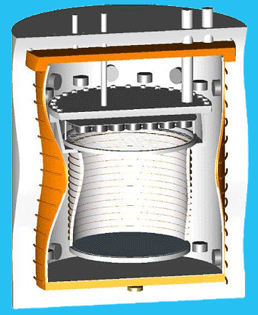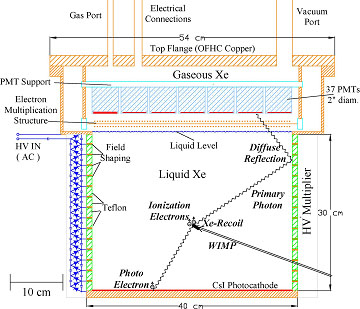XENON10 Experiment
Overview
XENON is a next-generation Dark Matter Direct Detection experiment, which will
use liquid xenon as a sensitive detector medium to search for WIMPs (Weakly
Interacting Massive Particles). These particles, postulated by Super Symmetry
(SUSY), are believed to have a mass in the neighborhood of 100 GeV, to ignore
Electromagntic Interactions, and to permeate the Universe

XENON plans to probe the lowest SUSY parameter space, with a sensitivity of 1
event/100 kg/year. The project is funded by the National Science Foundation for
a Phase I study. Development and support of a US National Underground
Laboratory and a strong worldwide collaboration will make XENON one of the most
promising dark matter searches.
A schematic representation of the XENON design is shown above. An array of 10
such position-sensitive liquid xenon time projection chambers (LXeTPC) will
make the detector a tonne-scale experiment. Each TPC will comprise 100 kg of
active xenon mass, and be self-shielded with additional LXe.
A modular approach is preferred over a single detector for several reasons. The
most important is simply a feasibility argument: we have already built a 30 kg
LXeTPC and have used it for several balloon fights of the Liquid Xenon
Gamma-Ray Imaging Telescope (LXeGRIT).
The experience gained through this development effort, and the prior years of
R&D on noble liquid detectors, give us the confidence that a 100 kg TPC
optimized for dark matter detection can be built successfully. With an array, a
failure of one module would not halt the entire experiment. Operational
effciency is clearly higher than with a monolithic detector of 1-tonne.
Principle

As shown above, the LXeTPC module containing the active xenon target is formed by a sandwich of Teflon spacers (UV diffuse reflector) and copper rings for electric field shaping. The structure is closed at the bottom by a copper plate, which is coated with CsI to convert Xe scintillation photons into free electrons. The structure forms a 30 cm high cylinder with 38 cm inner diameter, holding about 100 kg of ultra pure liquid xenon.
On the top, the structure is hermetically sealed with a cylindrical copper vessel of larger diameter, housing the PMTs and the wire structure for the proportional scintillation process in the gas phase. The LXeTPC structure is enclosed in a copper vessel containing the liquid xenon for active shielding. With both detectors at the same temperature and similar pressure, the amount of material for the inner detector walls is minimized. The scintillation light from the shield section is viewed by two rings of 16 PMTs each.
 Top Top
|